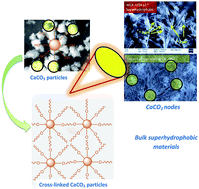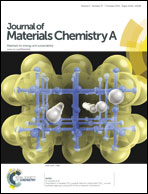Bulk superhydrophobic materials: a facile and efficient approach to access superhydrophobicity by silane and urethane chemistries†
Abstract
A promising method for constructing ‘bulk’ level superhydrophobicity on CaCO3 microparticles has been developed by employing silane and urethane chemistries in sequence. Silanol-terminated short-chain polydimethyl siloxane (PDMS) segments were grafted onto a CaCO3 surface. The particles were characterised by Fourier transform infrared (FTIR) spectroscopy, Raman spectroscopy, and GPC analyses. By the reaction of silanol groups on the surface of CaCO3 particles with isocyanate functionalities, the crosslinking of particles was accomplished. The resultant coating exhibited a water contact angle >150° with a sliding angle approximately 5–8° on the entire material. The bulk level SH behaviour is attributed to both inter- and intraparticle hydrogen bonding, which was substantiated by FTIR. The rod-shaped morphology of the bulk material was evidenced in SEM images and resulted due to the encasing of well-connected microparticles by PDMS chains.


 Please wait while we load your content...
Please wait while we load your content...